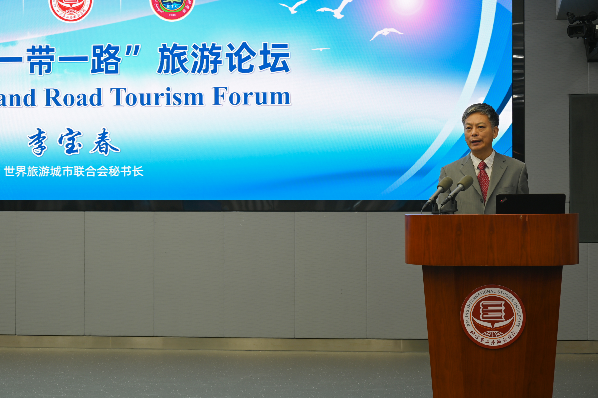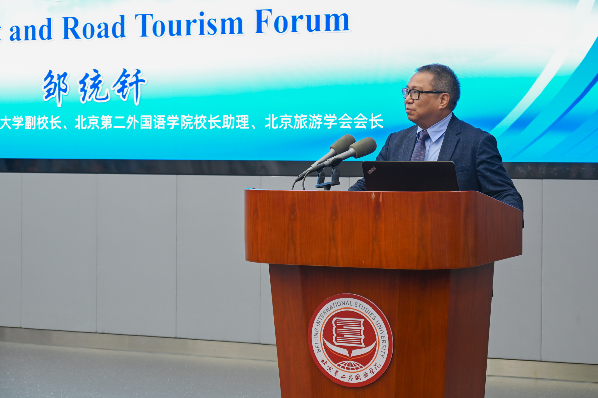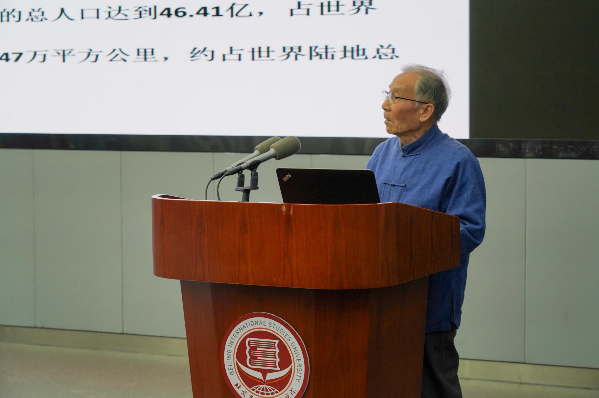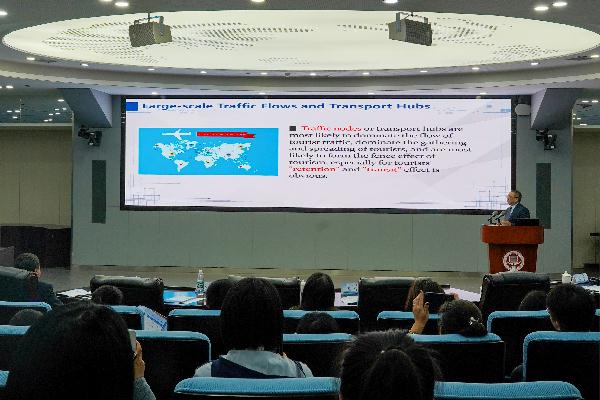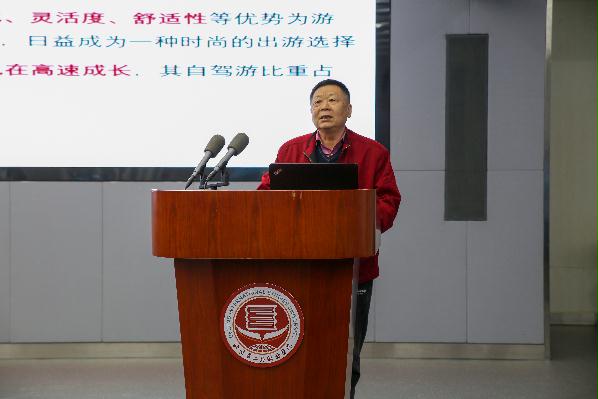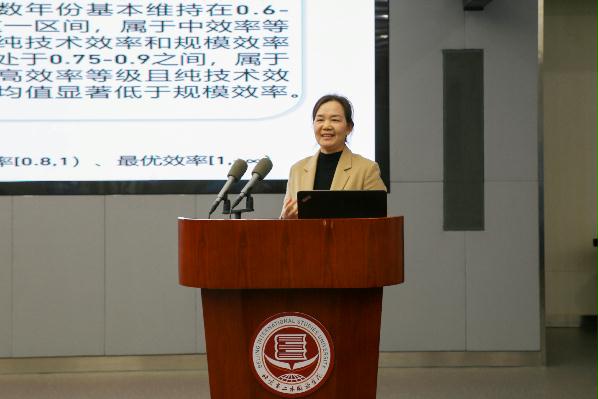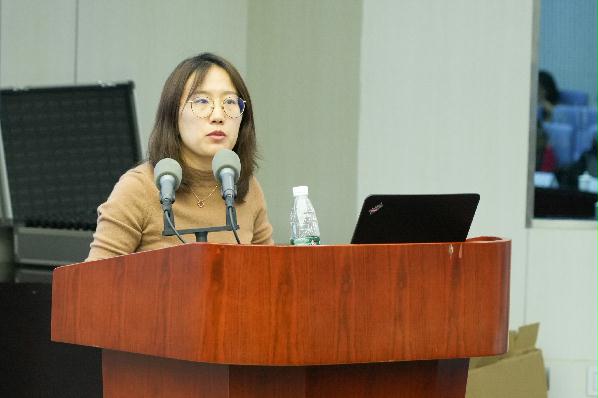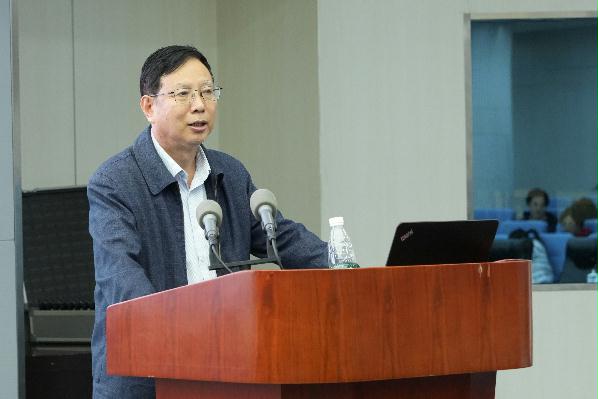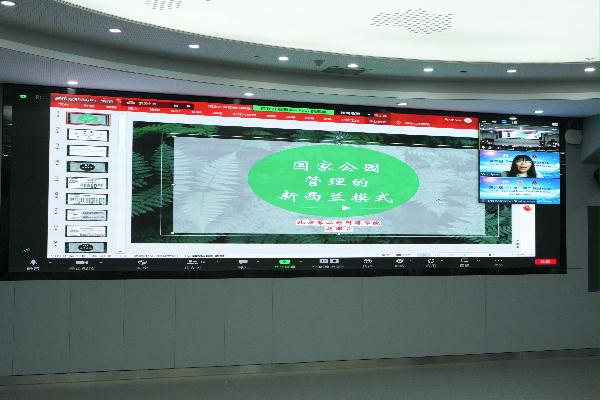 |
English |
|
Successful Hosting of the 6th Belt and Road Tourism Forum
|
||||
|
||||
|
On November 4, 2023, the 6th Belt and Road Tourism Forum was successfully held. With the theme of “The 10th Anniversary of the Belt and Road Initiative: Tourism Cooperation and Development”, the Forum reviewed the successful experience in the construction and development of the tourism industry of the Belt and Road Initiative, proposed a high-quality development path for the tourism industry of the Belt and Road Initiative in the future, and put forward constructive suggestions for the long-term development of the tourism industry. The forum was hosted by Beijing International Studies University, “Silk Road” International University of Tourism and Cultural Heritage and HeTian Normal College.
Cheng Wei, Vice President of Beijing International Studies University, Li Baochun, Secretary-general of World Tourism Cities Federation, Huang Kan, President of Beijing Education Association for International Exchange, Zou Tongqian, Vice President of “Silk Road” International University of Tourism and Cultural Heritage; Assistant President of Beijing International Studies University; President of Beijing Tourism Association attended the opening ceremony and delivered a speech. The opening ceremony was presided over by Li Pengbo, Deputy Director of the Research Department of Beijing International Studies University. The participating experts and scholars gave keynote speeches on the tourism development of China, Uzbekistan, the United States, Russia, Mongolia, France, New Zealand, Bangladesh and other countries, providing ideas for the construction of the Belt and Road Tourism.
Fig1. Professor Cheng Wei, Vice President of Beijing International Studies University, delivered a speech
In the opening speech, Cheng Wei, Vice President of Beijing International Studies University, said that tourism, as an essential part of the Belt and Road, has played an important role in enhancing the friendship between the founding of the Republic of China, promoting infrastructure improvement and regional economic development, and has become an essential bridge for cultural exchanges and economic cooperation between the founding of the Belt and Road, and a pivotal link to promote people-to-people sales and jointly build shared prosperity. Beijing International Studies University actively responds to the Belt and Road, gives full play to its professional and academic advantages, and provides strong support for the Belt and Road construction in personnel training, international exchanges and cooperation, and think tank construction. Fig2. Li Baochun, Secretary-general of World Tourism Cities Federation, delivered a speech
Li Baochun, Secretary-general of the World Tourism Cities Federation, said that “the road is not alone, the world is one family.” with the continuous expansion of the global tourism market and the upgrading of the tourism consumption structure, tourism cities need to build consensus, the towns, scenic spots, scenic spot resources into a series of points, to create diversified tourism routes. We will promote the integrated development of tourism with other industries, promote the diversification and differentiation of the tourism market, and provide tourists with more high-quality and distinctive tourism products and services. We will actively carry out cross-regional international cultural exchanges and tourism promotion activities and jointly explore a path for the coordinated development of world tourism. Fig3. Huang Kan, President of Beijing Education Association for International Exchange, delivered a speech
Huang Kan, President of Beijing Education Association for International Exchange, said that the Belt and Road connects China with the world and Asia with other continents, providing a platform and opportunity for everyone to enhance understanding and cooperation. China’s tourism industry is looking forward to sharing, win-win cooperation and creating new business opportunities with other countries and regions. At the same time, education is also an important area of cooperation under the Belt and Road Initiative, and we look forward to further cooperation in education.
Fig4. Zou Tongqian, Vice President of “Silk Road” International University of Tourism and Cultural Heritage; Assistant President of Beijing International Studies University; President of Beijing Tourism Association delivered a speech
Zou Tongqian, Vice President of “Silk Road” International University of Tourism and Cultural Heritage delivered a speech. In his view, Silk Road International University of Tourism and Cultural Heritage has a high starting point, has been valued by leaders of many countries, and is deeply supported by the Uzbek government. Beijing International Studies University and the University of Silk Road International Tourism and Cultural Heritage have worked closely together, exchanged and learned from each other, and hoped to jointly promote the development of the "Belt and Road" tourism. We also welcome experts and scholars to visit the Silk Road International Tourism and Cultural Heritage University for field guidance.
Fig5. Li Yukai, Secretary of CPC Committee of HeTian Normal College delivered a speech
Li Yukai, Secretary of CPC Committee of HeTian Normal College delivered a speech. He pointed out that Xinjiang, as the core region of the Belt and Road, has rich natural and cultural landscapes, and should take advantage of historical opportunities to vigorously cultivate cultural and tourism talents and develop and expand cultural and tourism industries.
Fig6. The opening ceremony was presided over by Li Pengbo, the morning forumwas presided over by Professor Lv Ning, Dean of School of Tourism Science, Beijing International Studies University; Secretary-general of Beijing Tourism Association
Professor Lv Ning, Dean of School of Tourism Science, Beijing International Studies University; Secretary-general of Beijing Tourism Association, Liu Chun, Associate Professor, School of Tourism Science, Beijing International Studies University, Professor Wang Xin, Vice President of China Academy of Culture and Tourism of Beijing International Studies University, presided over the 10th Anniversary of the Belt and Road Initiative: Tourism Cooperation and Development Forum.
Fig7. Wang Xingbin, Professor, Chief Expert of China Academy of Culture and Tourism , Beijing International Studies University delivered a speech
Wang Xingbin, Professor, Chief Expert of China Academy of Culture and Tourism , Beijing International Studies University delivered a speech on “The Key and Difficult Points in Developing the Belt and Road International Tourism”. He measured the number of international inbound and outbound tourists from mainland China, analyzed the current weaknesses of the Silk Road international tourism, and introduced the Silk Road Tourism Cities Alliance, which proposed the formation of the Silk Road Tourism Cities Alliance expert consulting library, which should be actively pursued to join the multi-party alliance to make up for the existing gaps in the Silk Road Tourism Cities Alliance.
Fig8. Zhao Jinlin, Professor, Director of Graduate School, School of Hotel and Tourism Management, Florida International University, USA, delivered a speech
Zhao Jinlin, Professor, Director of Graduate School, School of Hotel and Tourism Management, Florida International University, USA, delivered a speech on “Sports Events & Delicious Food and the Belt and Road”. As a participant of the Olympic Games and the Asian Games, Professor Zhao talked about the relationship between Belt and Road and sports, and the relationship between Belt and Road and food, and showed us the preparation of sports events and the importance of food to sports events from an inside perspective.
Fig9. Pan Bing, Professor, Doctoral Supervisor, Department of Leisure Park Tourism Management, Penn State University, USA, delivered a speech
Pan Bing, Professor, Doctoral Supervisor, Department of Leisure Park Tourism Management, Penn State University, USA, delivered a speech on “Heritage Preservation and Tourism Development: The Charleston Story”. In the form of telling the story of Charleston, he led to the development of tourism, and proposed targeted and constructive countermeasures against the challenges faced by Charleston, with a view to promoting the development of tourism in Charleston.
Fig10. Zou Tongqian, Professor, Vice President of “Silk Road” International University of Tourism and Cultural Heritage; Assistant President of Beijing International Studies University; President of Beijing Tourism Association, delivered a speech
Zou Tongqian delivered a speech on “The Fence Effects of the Belt and Road Tourism”. He explained the structure of the fence effect, explored the influencing factors of the formation of the tourist fence effect, said that traffic has a significant impact on the fence effect, and analyzed the possibility of whether Central Asia can become the fifth pillar of the fence effect, and put forward constructive suggestions for the development of tourism in Central Asia.
Fig11. Dong Suocheng, Chairman of the International Alliance of Scientists for the Belt and Road Initiative delivered a speech
Dong Suocheng, Chairman of the International Alliance of Scientists for the Belt and Road Initiative delivered a speech on “The Patterns of Tourism Resources and Models of Green and Low-carbon International Tourism of the Belt and Road Tourism”. From the two aspects of the pattern of tourism resources along the Belt and Road and the green and low-carbon international tourism model, he detailed the natural and cultural resources of the Silk Road, the future potential market, the problems faced, and the global tourism building strategy based on “green and low-carbon”.
Fig12. Yao Hua, Professor, Former Secretary of the First Affiliated Hospital CPC Committee of Xinjiang Medical Universitydelivered a speech
Yao Hua, Professor, Former Secretary of the First Affiliated Hospital CPC Committee of Xinjiang Medical Universitydelivered a speech on “The Development Prospect of China’s Health Tourism under the Background of the Belt and Road”. According to the three levels of health, tourism, and health tourism, he explained the meaning of health tourism and the relationship between the three in depth from far to near and made an excellent prospect for the future development of health tourism.
Fig13. Wang Xiaoyu, Distinguished Expert of World Tourism Cities Federation, Distinguished Researcher of Tourism Research Center of Chinese Academy of Social Sciences delivered a speech
Wang Xiaoyu, Distinguished Expert of World Tourism Cities Federation, Distinguished Researcher of Tourism Research Center of Chinese Academy of Social Sciences delivered a speech on “Investment Opportunities along the Belt and Road: Investment and Development Strategies of Chinese Cultural and Tourism Enterprises”. He explained four aspects of the Belt and Road resources and market status, national cultural tourism consumption demand and change trend, Belt and Road cultural tourism investment and trend, “Belt and Road” investment risk control, and showed us the application scenarios of tourism and the future market trend from the perspective of the industry.
Fig14. Wu Dianting, Professor, Doctoral Supervisor , Faculty of Geographical Science, Beijing Normal University, delivered a speech
Wu Dianting, Professor, Doctoral Supervisor , Faculty of Geographical Science, Beijing Normal University, delivered a speech on “Study on China-Mongolian-Russia Co-construction of Beijing-Ulaanbaatar-- Baikal-Moscow Self-driving Tourism Route”. He elaborated on the five aspects of the self-driving tourism route according to the critical points of the program: necessity, feasibility, development ideas and preliminary ideas, fundamental problems and precautions, and provided a feasible plan for the joint construction of tourism between China, Mongolia, and Russia.
Fig15. Li Huiqin, Professor, Director of Tourism Management Department, School of Economics and Management, China University of Geoscience, delivered a speech
Li Huiqin, Professor, Director of Tourism Management Department, School of Economics and Management, China University of Geoscience, delivered a speech on “Spatio-temporal Evolution and Influencing Factors of Tourism Efficiency in China’s Top 100 Tourism Counties”. She used efficiency measurement to analyze the spatial and temporal evolution characteristics and influencing factors of tourism efficiency in the top 100 counties in the past 20 years, revealing its spatial effects, and said that the future should improve the technical efficiency of tourism, optimize the industrial structure, and promote the flow and focus of factors. Fig16. Liu Chun, Associate Professor of School of Tourism Science , Beijing International Studies University hosted the afternoon sub-session
Fig17. Professor Wang Xin, Associate Dean of China Academy of Culture & Tourism, Beijing International Studies University hosted the afternoon session
The afternoon’s sessionwas held by Liu Chun, Associate Professor of School of Tourism Science, Beijing International Studies University, andProfessor Wang Xin, Associate Dean of China Academy of Culture & Tourism, Beijing International Studies University.
Fig18. Li Chang, Professor, Tsinghua Universit, delivered a speech Li Chang, Professor, Tsinghua Universit, delivered a speech on “Strengthen Exchanges of Folk Culture and Art, Facilitate the Integrated Development of Tourism along the Belt and Road”. Cultural exchange is conducive to promoting the tourism integration and enhancing mutual understanding. Therefore, in the future, it should be a major development direction to build a folk-art exchange platform in countries along the "One Belt and one Road".
Fig19.Han Jingting, Secretary-general of the Working Committee of Metauniverse and Geospatial Information of China Association for Geospatial Industry and Sciences delivered a speech
Han Jingting, Secretary-general of the Working Committee of Metauniverse and Geospatial Information of China Association for Geospatial Industry and Sciences delivered a speech on “The Application of New Technologies (Digital Twin) in Heritage Conservation”. Digital Twin Technology provides new ideas and tools for the innovation and development of digital protection, inheritance, development, and utilization of cultural heritage. Digital Twin Technology has some specific applications in heritage protection, but generally speaking, the digital process is still in the early stage of development, which is a challenge and opportunity; capital, talent, and technology are indispensable, and digital twins can help heritage protection.
Fig20. Feng Xingyu, Postdoctor of Social Sciences Academic Press, delivered a speech
Feng Xingyu, Postdoctor of Social Sciences Academic Press, delivered a speech on “The Cultural Value Unicom of the Material and Cultural Heritage in “Silk Road” Initiated Country”. As a trade route with a long history, the “Silk Road” has rich cultural heritage connotations, including the concreteness of identity values, the inclusiveness of diverse cultures, and the historicity of cultural values connected through religious beliefs, handicrafts, architecture, and skills. In the future, protecting and inheriting these connectivity modes is still necessary. It is committed to promoting the international exchange and dissemination of such cultural heritage.
Fig21. Li Yan, Associate Professor of China Academy of Culture & Tourism, Beijing International Studies University, delivered a speech
Li Yan, Associate Professor of China Academy of Culture & Tourism, Beijing International Studies University, delivered a speech on “Exploring Trends of Cultural Heritage Inheritance and Tourism Utilization in Central Asian Countries”. With a long and rich cultural heritage and resources, the Central Asian countries have the potential to become excellent tourist destinations. However, at present, the cultural heritage inheritance and tourism activation of Central Asian countries still face some challenges, including war and political turmoil, lack of systematic and long-term management mechanism, lack of professional personnel and financial support, etc. In the future, it is necessary to continue to optimize infrastructure construction, strengthen financial and personnel support, and strengthen cultural exchanges and mutual learning.
Fig22. Yin Tiantian, Doctoral Student, University of Paris I, France, delivered a speech
Yin Tiantian, Doctoral Student, University of Paris I, France, delivered a speech on “Sino-French Ecovalue-based Industrial Convergence of Rural Tourism Grange: Establishment of Cross-Cultural Standards and Guidelines”. She focused on the background and progress of the establishment of the ecological, financial production rural tourism farm project, stressed the necessity of building an environmental integrated rural tourism model in promoting the integrated development of rural tourism, and shared the specific content of the guide and the future development vision of the project.
Fig23. Wu Liyun, Associate Professor of China Academy of Culture & Tourism, Beijing International Studies University, delivered a speech
Wu Liyun, Associate Professor of China Academy of Culture & Tourism, Beijing International Studies University, delivered a speech on “The New Zealand model of National Park Management”. She discussed New Zealand’s successful experience in national park management from seven aspects: management organization, laws and regulations, funding system, protection system, utilization mode, leadership and service system, and social participation. She also mentioned some best practices in New Zealand’s management model. New Zealand’s unique management model has specific reference significance for constructing and managing China's national park system.
Fig24. Wang Zhongjun, Director of the Department of Eco-Tourism Planning and Management of Beijing Forestry University, delivered a speech
Wang Zhongjun, Director of the Department of Eco-Tourism Planning and Management of Beijing Forestry University, delivered a speech on “Research on Tourism Investment Environment and Risk Assessment of Countries along the Belt and Road”. He focused on the countries along the Belt and Road, intensely studied the tourism investment environment and related risk factors, and revealed the current status and characteristics of the Belt and Road tourism investment. It is suggested that the future Belt and Road tourism investment should pay attention to the difference in resources and choose the investment region reasonably; Pay attention to the current situation of the tourism industry and avoid a single investment mode; Actively look for partners to create high-quality tourism routes is crucial to the sustainable development of the "Belt and Road" tourism industry.。
Fig25. Atem Klykov, Professor, “Silk Road” International University of Tourism and Cultural Heritag, delivered a speech
Atem Klykov, Professor, “Silk Road” International University of Tourism and Cultural Heritag, delivered a speech on “The Development Trend of Russian Tourism”. He analyzed the current situation of Russian tourism, development opportunities, and the rich achievements of tourism cooperation between Russia and China. From the existing tourism resources of various cities, he stressed the vast tourism potential of Russia, including natural beauty, rich cultural heritage, and diversified tourism experiences. Fig26. Han Huilin, Associate professor, School of Tourism Management, Beijing Open University, delivered a speech
Han Huilin, Associate professor, School of Tourism Management, Beijing Open University, delivered a speech on “Research on the Construction of Silk Road Tourism Brand Sharing Mechanism under the Belt and Road Strategy”. She focused on sharing tourism brands among the Northwest Silk Road cities to promote sustainable tourism development under the Belt and Road strategy. At present, the Northwest Silk Road brand image could be more precise, and the brand competitiveness could be more substantial, so it is necessary to identify the brand positioning and build the overall picture. Integrate communication channels and strengthen brand promotion; Attach importance to resource protection and improve brand management; Strengthen the flow of talents and realize cross-regional sharing and integration; Sign a cooperation contract, establish a balance of interests and compensation mechanism to optimize the tourism brand promotion mechanism.
Fig27. Shahparan Mohanmod, Lecturer,“Silk Road” International University of Tourism and Cultural Heritag, delivered a speech Shahparan Mohanmod, Lecturer, “Silk Road” International University of Tourism and Cultural Heritag, delivered a speech on “The Tourism Development Strategy of Bangladesh”. Bangladesh has rich natural landscapes, historical and cultural heritage, which provides great potential for developing tourism in Bangladesh. In the future, Bangladesh can further optimize its tourism conditions by improving infrastructure, carrying out joint marketing, developing characteristic accommodation facilities, and strengthening security.
Fig28. Zhang Xinli, Director of Information and Intelligence Office, China National Travel Service Group Corporation Limite, delivered a speec
Zhang Xinli, Director of Information and Intelligence Office, China National Travel Service Group Corporation Limited, delivered a speech on “Research on Investment, Construction and Development of the Belt and Road-- A Case Study of Business Development of China National Travel Service Group Corporation Limited”. Factors such as the current national environmental risks, non-traditional security risks such as explosive and terrorist attacks, and significant difficulties and problems other enterprises face have hindered the pace of Chinese enterprises to “go global”. In the future, the two domestic and international markets and resources will be well used, and the hot destinations of Chinese outbound tourism and countries along the Belt and Road will be essential nodes. Guided by advantageous businesses such as travel services and tourism retail, through external strategic cooperation, upstream and downstream coordination of the industrial chain, and a combination of online and offline channels, we will drive related tourism businesses to go to sea, extend from serving Chinese tourists to serving international tourists, radiate to regions from point to line, and realize global business layout in an orderly manner.
Fig29. The participants took a group photo
Finally, Professor Zou Tongqian, Vice President of Silk Road International Tourism and Cultural Heritage University, delivered the closing speech, thanking experts and scholars from universities, research institutions, social organizations, enterprises, and other organizations. From different dimensions of tourism, education, folk culture, sports, enterprise investment, cultural heritage, new technology, and so on, the review of tourism development and prospects of the tenth anniversary of the "Belt and Road" initiative is deeply discussed. It is pointed out that theoretical research and practical exploration should be further strengthened to strengthen the Belt and Road tourism market opening. The participation of the Institute of Chinese Culture and Tourism Industry of Beijing International Studies University in this forum is gratituded.
The successful holding of the 6th Belt and Road Tourism Forum has summarized the development of Belt and Road tourism in the past ten years and put forward constructive suggestions for promoting the steady and long-term outcome of Belt and Road tourism cooperation in the next stage, which is of important theoretical and practical guiding significance.
Contributors: Zou Mingyue, Zhang Lirong, Pang Yuexia |
||||

